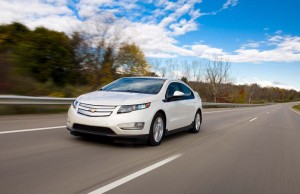Hoping to get potential buyers to plug in, Chevrolet is giving the Volt a jolt by cutting the extended-range electric vehicles price by $5,000 for the 2014 model-year.
The maker had already cut the cost of the 2013 model by $4,000 and offered a $5,000 giveback on leftover 2012 Chevrolet Volts. The latest move comes in the wake of a 3.3% decline in sales of the battery car last month. And while Volt sales are up 9.2% for the first seven months of the year, that lags well behind the surge in demand for two key competitors in the new battery-car segment, the Nissan Leaf and the Tesla Model S.
Chevy isn’t alone, however, in using discounts to try to draw buyers into showrooms. In fact, the big 371.9% jump in sales of the Leaf battery-electric vehicle, or BEV, followed the Japanese maker’s announcement of its own big prices cuts early in the year. Nissan recently launched production at an assembly plant in Smyrna, Tennessee – the sprawling complex also producing Leaf batteries. It followed by adding a new stripped-down model and trimming prices on more well-equipped versions of the BEV.
The Volt and Leaf are often compared to one another, though the Chevy plug-in adds a backup gas engine that allows the vehicle to keep going even after its battery is drained – nominally after 38 miles of driving, according to the EPA.
(EV makers slash prices to spur sales. Click Here for the full story.)
While that extended-range feature helped the Volt win honors as North American Car of the Year several years ago, industry analysts have cautioned that for many potential buyers the initial price tag of around $40,000 was simply too much.
“Dropping the Volt’s price removes one of the primary consideration barriers for most buyers,” said Karl Brauer, senior analyst at Kelley Blue Book.
The price of the Volt had already come down from the original $41,000 MSRP on the original 2010 model. For 2014, the Chevrolet Volt will carry a $34,995 sticker – including delivery charges — $5,000, or 12.5%, less than what General Motors was demanding at the start of the 2013 model-year.
(GM cuts price on 2013 Volt, leftover 2012 models. Click Herefor details.)
And buyers will generally qualify for $7,500 in federal tax credits as well as incentives in states such as California and Colorado that could bring the final price down to the mid-$20,000 range.
(BMW reveals new i3 battery-car, prices it at $42,000. Click Herefor more.)
For their part, GM officials tried to put a positive spin on the latest price cut, Don Johnson, U.S. vice president, Chevrolet sales and service, explaining that, “We have made great strides in reducing costs as we gain experience with electric vehicles and their components.”
Indeed, the maker has long promised to pass savings onto consumers as it was able to reduce the initially hefty cost of the Volt’s lithium-ion batteries and other key parts. Other makers, including Nissan, have taken similar stands. And while industry analysts caution that battery prices have a long way to go before they reach a level where a battery drivetrain is comparable in price to a gasoline powertrain, costs have begun to drop.
At the time the Chevrolet Volt and Nissan Leaf were launched in late 2010, industry insiders suggested that the going rate for a kilowatt-hour of lithium-ion batteries ran between $700 and $1,000. While manufacturers are loathe to offer specific, various sources tell TheDetroitBureau.com that with growing availability LIon prices have dropped to as little as $400 per kWh. And the general expectation is that they could dip to $200 or under by decade’s end.
Meanwhile, energy density – the amount of power stored in a given mass – is rising, meaning smaller, lighter batteries for future models.
Part of GM’s problem, however, was the maker’s conservative approach to engineering the Volt drivetrain. The plug-in is fitted with a 16.5 kWh lithium battery pack which yields an estimated 38 miles per charge. The Nissan Leaf has 24 kWh for almost 90 miles of range. Where GM holds about a third of its battery in reserve to extend its life, competitors like Tesla draw from nearly 90% of their battery packs.
In recent months, with the overall plug-based vehicle market lagging early sales expectations, most manufacturers have been forced to cut price on models such as the new Honda Fit EV and Ford Focus EV.
But industry watchers caution that this only resolves one of the broad concerns potential buyers have. They stress that battery range will have to rise even as a nationwide network of battery charging stations is put into place.


The big car companies are lowering EV prices in desperation but don’t worry they’ll up the prices on the other models to subsidize the impractical EVs that the car makers need to get people to buy in an effort to meet the absurd 54.5 mpg CAFE standards that Obama and the EPA are cramming down the throats of the car makers. It’s pure insanity.
I actually saw one. There it was, sitting in the parking lot all by its lonesome. It must have been there a while because it had dirty tires and windows. I couldn’t find any political bumper stickers…odd, I thought.
Where is Edsel when we most need him.
Oh Lord, where are those Fuel Cell cars when we are really going to need them and soon.
GM probably forced all dealers to take some of the Volts in an effort to get consumers to buy them. Consumers need to be conditioned to buy impractical vehicles to help with the impossible CAFE requirements.